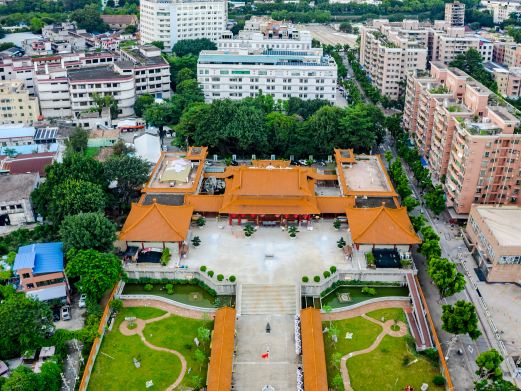Linggui Garden, located on the banks of the Xijiang River in the eastern suburbs of Hecheng District, is a historical scenic spot in Gaoming City. The garden houses two ancient sites – the Linggui Pagoda and the Tang Dynasty Dragon Kiln site, both of which are provincially protected cultural relics. In the 29th year of the Wanli era of the Ming Dynasty (1601), Qu Darun, a poet and Jinshi from Lingnan, donated silver to build this pagoda on the Turtle Peak and composed the ‘Turtle Peak Pagoda Inscription’: ‘The towering Turtle Peak rises from the river, the pagoda emerges as a pillar to the sky. Bringing auspiciousness to thrive, with many sages, they assist the emperor for countless years.’ Due to the legend that the Turtle Peak was transformed from a divine turtle, the pagoda is named Linggui Pagoda.
Linggui Pagoda is built on the Turtle Peak Mountain by the river and is an octagonal seven-story brick structure, 32.3 meters high, without a base. The first floor has two opposing doors, with a diameter of 7.2 meters and an inner diameter of 2.4 meters. Originally, there were two Buddha statues inside, which have been lost. From the second floor upwards, each floor has four doors, with flat seats and railings on each level. The fifth layer uses five-layered dental bricks to cantilever the eaves, and the eaves are decorated with colored glaze tiles. The first floor has a spacious auxiliary corridor around it, and the pagoda top is a towering wheel, which was renovated in 1984. About Turtle Peak Mountain and Linggui Pagoda, there is a beautiful and touching legend: It is said that in ancient times, poisonous snakes, fierce beasts, and poisonous mists were the three troubles. People prayed to the heavens for protection, and finally moved the divine turtle, which came up the river and used its magical power to disperse the poisonous mists, subdue the snakes and beasts, and benefit the local people. However, the turtle died of exhaustion and turned into a mountain by the river, known as Turtle Peak Mountain. Later generations built Linggui Pagoda on the mountain to commemorate the divine turtle. The legend embodies the beautiful wishes of the people of Gaoming. Historical records show that Linggui Pagoda was built in the 29th year of the Wanli era of the Ming Dynasty (AD 1061) by Qu Daxiang, a Jinshi from Gaoming County, with donated funds. The pagoda is an octagonal seven-story structure, 32.2 meters high, with each eave decorated with animal-shaped colored glaze tiles. The pagoda stands tall and elegant, overlooking the beautiful Xique Mountain in the distance, and the surging Xijiang River nearby, reflecting the Gaoming New City, creating a spectacular scene. The Tang Dynasty Dragon Kiln site is the first of its kind discovered in Guangdong, with hundreds of pieces of pottery such as bowls, plates, basins, jars, and pots with distinctive Tang Dynasty characteristics unearthed. To protect this precious cultural heritage, the municipal government funded the construction of the Gaoming City Museum on the basis of preserving the site. The museum displays precious cultural relics unearthed from various dynasties within Gaoming City, witnessing the long and profound historical process of human culture in Gaoming. Linggui Garden has undergone two major renovations in 1984 and 1998, preserving the style and characteristics of ancient architecture. The garden integrates mountains and waters, clear and bright, with newly built sunken squares, calligraphy and painting corridors, lotus pond views, and winding paths with small bridges. Ancient culture and modern civilization blend within Linggui Garden, creating a harmonious and beautiful scene. The garden is open all year round, and the exterior is accessible all day long.Linggui Pagoda
Linggui Garden, located on the banks of the Xijiang River in the eastern suburbs of Hecheng District[...]









